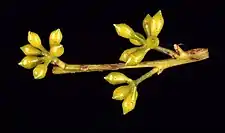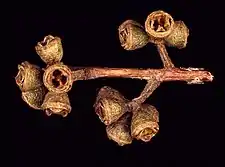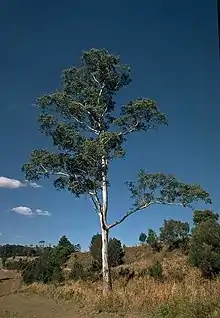Eucalyptus dorrigoensis
Eucalyptus dorrigoensis, commonly known as the Dorrigo white gum,[3] is a species of tree that is endemic to New South Wales. It has smooth white, grey or pink bark, lance-shaped to curved adult leaves, flower buds in groups of seven, white flowers and cup-shaped, conical or hemispherical fruit.


| Dorrigo white-gum | |
|---|---|
 | |
| Eucalyptus dorrigoensis growing near Dorrigo | |
| Scientific classification | |
| Kingdom: | Plantae |
| Clade: | Tracheophytes |
| Clade: | Angiosperms |
| Clade: | Eudicots |
| Clade: | Rosids |
| Order: | Myrtales |
| Family: | Myrtaceae |
| Genus: | Eucalyptus |
| Species: | E. dorrigoensis |
| Binomial name | |
| Eucalyptus dorrigoensis | |
| Synonyms[2] | |
| |
Description
Eucalyptus dorrigoensis is a tree that typically grows to a height of 30 m (98 ft) and forms a lignotuber. It has smooth, slightly powdery white, grey or pink bark, sometimes with slabs of rough bark near the base. Young plants and coppice regrowth have warty stems, the leaves arranged in opposite pairs and egg-shaped to broadly lance-shaped, 35–80 mm (1.4–3.1 in) long and 13–40 mm (0.51–1.57 in) wide. Adult leaves are the same colour on both sides, lance-shaped to curved, 60–220 mm (2.4–8.7 in) long and 12–27 mm (0.47–1.06 in) wide on a petiole 5–25 mm (0.20–0.98 in) long. The flower buds are arranged in groups of seven in leaf axils on an unbranched peduncle 4–10 mm (0.16–0.39 in) long, the individual buds on a pedicel 1–3 mm (0.039–0.118 in) long. Mature buds are oval, 4–5 mm (0.16–0.20 in) long and 2–3 mm (0.079–0.118 in) wide with a conical operculum. Flowering occurs in May and the flowers are white. The fruit is a woody conical or hemispherical capsule 3–4 mm (0.12–0.16 in) long and 4–5 mm (0.16–0.20 in) wide with the valves extended beyond the rim.[3][4][5][6]
Taxonomy and naming
Dorrigo white gum was first formally described in 1934 by William Blakely in his book A Key to Eucalypts and given the name Eucalyptus benthamii var. dorrigoensis.[7] In 1990, Lawrie Johnson and Ken Hill raised the variety to species status as Eucalyptus dorrigoensis.[5][8] The specific epithet (dorrigoensis) is a reference to the distribution of this species near Dorrigo - the ending -ensis is a Latin suffix "denoting place, locality [or] country".[4][9]
Distribution and habitat
Eucalyptus dorrigoensis grows in deep soils in valley forests from near the upper Macleay River to east of Tenterfield and mainly near Dorrigo.[3][6]
See also
References
- Fensham, R.; Laffineur, B.; Collingwood, T. (5 June 2019). "Eucalyptus dorrigoensis". IUCN Red List of Threatened Species. 2019: e.T133376028A133376030. doi:10.2305/IUCN.UK.2019-3.RLTS.T133376028A133376030.en. Retrieved 23 June 2023.
- "Eucalyptus dorrigoensis". Australian Plant Census. Retrieved 24 June 2019.
- Hill, Ken. "Eucalyptus dorrigoensis". Royal Botanic Garden Sydney. Retrieved 24 June 2019.
- "Eucalyptus dorrigoensis". Euclid: Centre for Australian National Biodiversity Research. Retrieved 4 June 2020.
- Johnson, Lawrence A.S.; Hill, Kenneth D. (26 September 1990). "New taxa and combinations in Eucalyptus and Angophora (Myrtaceae)". Telopea. 4 (1): 63. doi:10.7751/telopea19904916.
- Chippendale, George M. "Eucalyptus benthamii var. dorrigoensis". Australian Biological Resources Study, Department of the Environment and Energy, Canberra. Retrieved 24 June 2019.
- "Eucalyptus benthamii var. dorrigoensis". APNI. Retrieved 24 June 2019.
- "Eucalyptus dorrigoensis". APNI. Retrieved 24 June 2019.
- Brown, Roland Wilbur (1956). The Composition of Scientific Words. Washington, D.C.: Smithsonian Institution Press. p. 303.
